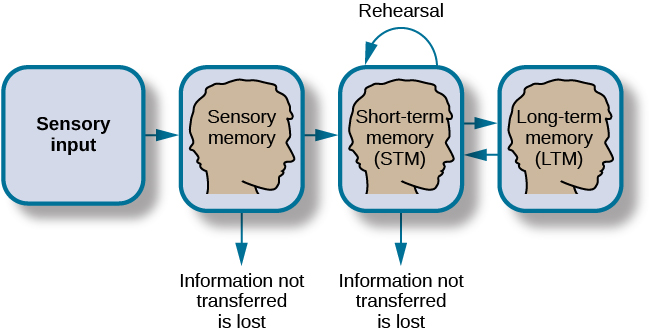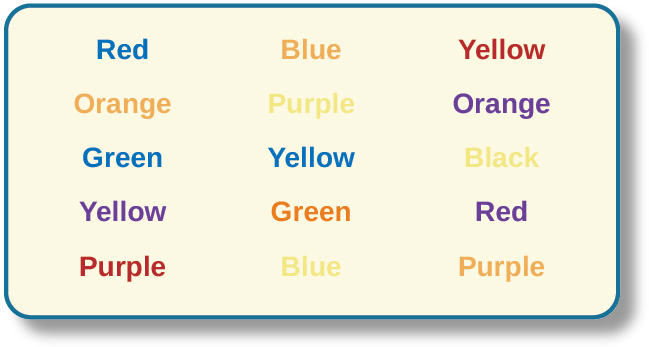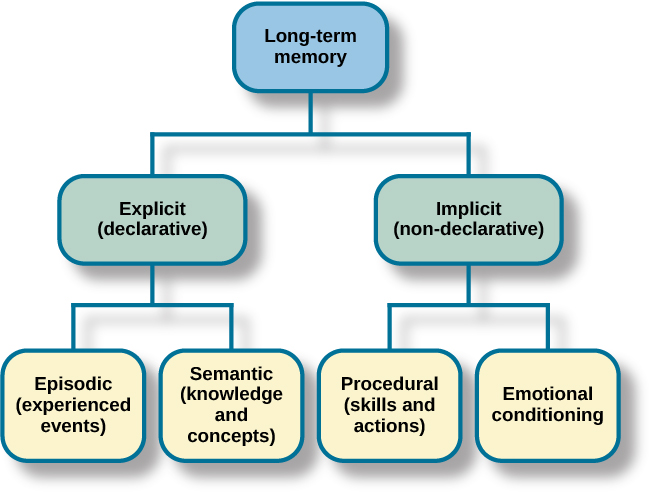8.2: كيف تعمل الذاكرة
- Page ID
- 198070
أهداف التعلم
- ناقش الوظائف الأساسية الثلاث للذاكرة
- وصف المراحل الثلاث لتخزين الذاكرة
- وصف وتمييز بين الذاكرة الإجرائية والتصريحية والذاكرة الدلالية والعرضية
الذاكرة هي نظام معالجة معلومات؛ لذلك، غالبًا ما نقارنها بجهاز كمبيوتر. الذاكرة هي مجموعة العمليات المستخدمة لتشفير المعلومات وتخزينها واسترجاعها على مدى فترات زمنية مختلفة.

التشفير
نحصل على المعلومات في أدمغتنا من خلال عملية تسمى الترميز، وهي إدخال المعلومات في نظام الذاكرة. بمجرد أن نتلقى المعلومات الحسية من البيئة، تقوم أدمغتنا بتسميتها أو ترميزها. ننظم المعلومات بمعلومات أخرى مماثلة ونربط المفاهيم الجديدة بالمفاهيم الحالية. تحدث معلومات الترميز من خلال المعالجة التلقائية والمعالجة المجهدة.
إذا سألك شخص ما عما تناولته على الغداء اليوم، فمن المرجح أن تتذكر هذه المعلومات بسهولة تامة. يُعرف هذا بالمعالجة التلقائية، أو ترميز التفاصيل مثل الوقت والمساحة والتردد ومعنى الكلمات. عادة ما تتم المعالجة التلقائية دون أي وعي واعي. يعد تذكر آخر مرة درست فيها للاختبار مثالًا آخر على المعالجة التلقائية. ولكن ماذا عن مادة الاختبار الفعلية التي درستها؟ ربما يتطلب الأمر الكثير من العمل والاهتمام من جانبك لتشفير تلك المعلومات. يُعرف هذا بالمعالجة المجهدة.

ما هي أكثر الطرق فعالية لضمان تشفير الذكريات المهمة بشكل جيد؟ حتى الجملة البسيطة يسهل تذكرها عندما تكون ذات معنى (Anderson، 1984). اقرأ الجمل التالية (Bransford & McCarrell، 1974)، ثم انظر بعيدًا وقم بالعد العكسي من\(30\) ثلاثة إلى صفر، ثم حاول كتابة الجمل (دون الرجوع إلى هذه الصفحة!).
- كانت الملاحظات حامضة بسبب انقسام اللحامات.
- لم تتأخر الرحلة بسبب تحطم الزجاجة.
- كانت كومة القش مهمة لأن القماش ممزق.
ما مدى جودة أدائك؟ في حد ذاتها، كانت العبارات التي كتبتها على الأرجح مربكة ويصعب عليك تذكرها. الآن، حاول كتابتها مرة أخرى، باستخدام التعليمات التالية: مزمار القربة، وتعميد السفن، والمظلي. بعد ذلك، عد إلى الوراء\(40\) من أربعة، ثم تحقق من نفسك لمعرفة مدى تذكيرك للجمل هذه المرة. يمكنك أن ترى أن الجمل أصبحت الآن لا تُنسى لأن كل جملة تم وضعها في سياقها. يتم ترميز المواد بشكل أفضل بكثير عندما تجعلها ذات معنى.
هناك ثلاثة أنواع من الترميز. يُعرف ترميز الكلمات ومعناها بالترميز الدلالي. تم عرضه لأول مرة من قبل ويليام بوسفيلد (1935) في تجربة طلب فيها من الناس حفظ الكلمات. تم تقسيم\(60\) الكلمات بالفعل إلى 4 فئات من المعنى، على الرغم من أن المشاركين لم يعرفوا ذلك لأن الكلمات تم تقديمها بشكل عشوائي. عندما طُلب منهم تذكر الكلمات، كانوا يميلون إلى تذكرها في فئات، مما يدل على أنهم اهتموا بمعاني الكلمات كما تعلموها.
الترميز المرئي هو ترميز الصور، والتشفير الصوتي هو ترميز الأصوات والكلمات على وجه الخصوص. لمعرفة كيفية عمل الترميز المرئي، اقرأ قائمة الكلمات هذه: السيارة، المستوى، الكلب، الحقيقة، الكتاب، القيمة. إذا طُلب منك لاحقًا تذكر الكلمات من هذه القائمة، فما الكلمات التي تعتقد أنك ستتذكرها على الأرجح؟ ربما سيكون لديك وقت أسهل في تذكر كلمات السيارة والكلب والكتاب، وستواجه صعوبة أكبر في تذكر مستوى الكلمات والحقيقة والقيمة. لماذا هذا؟ لأنه يمكنك تذكر الصور (الصور الذهنية) بسهولة أكبر من الكلمات وحدها. عندما تقرأ كلمات السيارة والكلب والكتاب، قمت بإنشاء صور لهذه الأشياء في ذهنك. هذه كلمات ملموسة عالية الصور. من ناحية أخرى، الكلمات المجردة مثل المستوى والحقيقة والقيمة هي كلمات منخفضة الصور. يتم ترميز الكلمات عالية الصور بصريًا ولدلاليًا (Paivio، 1986)، وبالتالي بناء ذاكرة أقوى.
الآن دعونا نوجه انتباهنا إلى الترميز الصوتي. أنت تقود سيارتك وتأتي أغنية على الراديو لم تسمعها منذ\(10\) سنوات على الأقل، لكنك تغني جنبًا إلى جنب، وتتذكر كل كلمة. في الولايات المتحدة، غالبًا ما يتعلم الأطفال الأبجدية من خلال الأغنية، ويتعلمون عدد الأيام في كل شهر من خلال القافية: «ثلاثون يومًا هي سبتمبر، /أبريل، يونيو، ونوفمبر؛ /كل الباقي له واحد وثلاثون، /انقذوا فبراير، مع ثمانية وعشرين يومًا واضحًا،/وتسعة وعشرون يومًا في كل قفزة عام.» من السهل تذكر هذه الدروس بسبب الترميز الصوتي. نقوم بتشفير الأصوات التي تصنعها الكلمات. هذا هو أحد الأسباب التي تجعل الكثير مما نعلمه للأطفال الصغار يتم من خلال الأغنية والقافية والإيقاع.
أي من أنواع الترميز الثلاثة تعتقد أنها ستمنحك أفضل ذاكرة للمعلومات اللفظية؟ قبل بضع سنوات، أجرى علماء النفس فيرغوس كريك وإندل تولفينج (1975) سلسلة من التجارب لمعرفة ذلك. تم إعطاء المشاركين كلمات مع أسئلة عنها. تطلبت الأسئلة من المشاركين معالجة الكلمات على أحد المستويات الثلاثة. تضمنت أسئلة المعالجة المرئية أشياء مثل سؤال المشاركين عن خط الحروف. سألت أسئلة المعالجة الصوتية المشاركين عن صوت الكلمات أو قافيتها، وسألت أسئلة المعالجة الدلالية المشاركين عن معنى الكلمات. بعد أن تم تقديم الكلمات والأسئلة للمشاركين، تم تكليفهم بمهمة استدعاء أو تقدير غير متوقعة.
تم تذكر الكلمات التي تم ترميزها دلاليًا بشكل أفضل من تلك المشفرة بصريًا أو صوتيًا. يتضمن الترميز الدلالي مستوى معالجة أعمق من الترميز المرئي أو الصوتي الضحل. استنتج Craik و Tulving أننا نعالج المعلومات اللفظية بشكل أفضل من خلال الترميز الدلالي، خاصة إذا طبقنا ما يسمى بتأثير المرجع الذاتي. تأثير المرجع الذاتي هو ميل الفرد إلى امتلاك ذاكرة أفضل للمعلومات المتعلقة بنفسه مقارنة بالمواد الأقل أهمية شخصية (Rogers، Kuiper & Kirker، 1977). هل يمكن أن يكون الترميز الدلالي مفيدًا لك أثناء محاولتك حفظ المفاهيم في هذا الفصل؟
Storage
Once the information has been encoded, we have to somehow have to retain it. Our brains take the encoded information and place it in storage. Storage is the creation of a permanent record of information.
In order for a memory to go into storage (i.e., long-term memory), it has to pass through three distinct stages: Sensory Memory, Short-Term Memory, and finally Long-Term Memory. These stages were first proposed by Richard Atkinson and Richard Shiffrin (1968). Their model of human memory, called Atkinson-Shiffrin (A-S), is based on the belief that we process memories in the same way that a computer processes information.

But A-S is just one model of memory. Others, such as Baddeley and Hitch (1974), have proposed a model where short-term memory itself has different forms. In this model, storing memories in short-term memory is like opening different files on a computer and adding information. The type of short-term memory (or computer file) depends on the type of information received. There are memories in visual-spatial form, as well as memories of spoken or written material, and they are stored in three short-term systems: a visuospatial sketchpad, an episodic buffer, and a phonological loop. According to Baddeley and Hitch, a central executive part of memory supervises or controls the flow of information to and from the three short-term systems.
Sensory Memory
In the Atkinson-Shiffrin model, stimuli from the environment are processed first in sensory memory: storage of brief sensory events, such as sights, sounds, and tastes. It is very brief storage—up to a couple of seconds. We are constantly bombarded with sensory information. We cannot absorb all of it, or even most of it. And most of it has no impact on our lives. For example, what was your professor wearing the last class period? As long as the professor was dressed appropriately, it does not really matter what she was wearing. Sensory information about sights, sounds, smells, and even textures, which we do not view as valuable information, we discard. If we view something as valuable, the information will move into our short-term memory system.
One study of sensory memory researched the significance of valuable information on short-term memory storage. J. R. Stroop discovered a memory phenomenon in the 1930s: you will name a color more easily if it appears printed in that color, which is called the Stroop effect. In other words, the word “red” will be named more quickly, regardless of the color the word appears in, than any word that is colored red. Try an experiment: name the colors of the words you are given in Figure. Do not read the words, but say the color the word is printed in. For example, upon seeing the word “yellow” in green print, you should say “green,” not “yellow.” This experiment is fun, but it’s not as easy as it seems.

Short-Term Memory
Short-term memory (STM) is a temporary storage system that processes incoming sensory memory; sometimes it is called working memory. Short-term memory takes information from sensory memory and sometimes connects that memory to something already in long-term memory. Short-term memory storage lasts about \(20\) seconds. George Miller (1956), in his research on the capacity of memory, found that most people can retain about \(7\) items in STM. Some remember \(5\), some \(9\), so he called the capacity of STM \(7\) plus or minus \(2\).
Think of short-term memory as the information you have displayed on your computer screen—a document, a spreadsheet, or a web page. Then, information in short-term memory goes to long-term memory (you save it to your hard drive), or it is discarded (you delete a document or close a web browser). This step of rehearsal, the conscious repetition of information to be remembered, to move STM into long-term memory is called memory consolidation.
You may find yourself asking, “How much information can our memory handle at once?” To explore the capacity and duration of your short-term memory, have a partner read the strings of random numbers out loud to you, beginning each string by saying, “Ready?” and ending each by saying, “Recall,” at which point you should try to write down the string of numbers from memory.

Note the longest string at which you got the series correct. For most people, this will be close to \(7\), Miller’s famous \(7\) plus or minus \(2\). Recall is somewhat better for random numbers than for random letters (Jacobs, 1887), and also often slightly better for information we hear (acoustic encoding) rather than see (visual encoding) (Anderson, 1969).
Long-term Memory
Long-term memory (LTM) is the continuous storage of information. Unlike short-term memory, the storage capacity of LTM has no limits. It encompasses all the things you can remember that happened more than just a few minutes ago to all of the things that you can remember that happened days, weeks, and years ago. In keeping with the computer analogy, the information in your LTM would be like the information you have saved on the hard drive. It isn’t there on your desktop (your short-term memory), but you can pull up this information when you want it, at least most of the time. Not all long-term memories are strong memories. Some memories can only be recalled through prompts. For example, you might easily recall a fact— “What is the capital of the United States?”—or a procedure—“How do you ride a bike?”—but you might struggle to recall the name of the restaurant you had dinner when you were on vacation in France last summer. A prompt, such as that the restaurant was named after its owner, who spoke to you about your shared interest in soccer, may help you recall the name of the restaurant.
Long-term memory is divided into two types: explicit and implicit. Understanding the different types is important because a person’s age or particular types of brain trauma or disorders can leave certain types of LTM intact while having disastrous consequences for other types. Explicit memories are those we consciously try to remember and recall. For example, if you are studying for your chemistry exam, the material you are learning will be part of your explicit memory. (Note: Sometimes, but not always, the terms explicit memory and declarative memory are used interchangeably.)
Implicit memories are memories that are not part of our consciousness. They are memories formed from behaviors. Implicit memory is also called non-declarative memory.

Procedural memory is a type of implicit memory: it stores information about how to do things. It is the memory for skilled actions, such as how to brush your teeth, how to drive a car, how to swim the crawl (freestyle) stroke. If you are learning how to swim freestyle, you practice the stroke: how to move your arms, how to turn your head to alternate breathing from side to side, and how to kick your legs. You would practice this many times until you become good at it. Once you learn how to swim freestyle and your body knows how to move through the water, you will never forget how to swim freestyle, even if you do not swim for a couple of decades. Similarly, if you present an accomplished guitarist with a guitar, even if he has not played in a long time, he will still be able to play quite well.
Declarative memory has to do with the storage of facts and events we personally experienced. Explicit (declarative) memory has two parts: semantic memory and episodic memory. Semantic means having to do with language and knowledge about language. An example would be the question “what does argumentative mean?” Stored in our semantic memory is knowledge about words, concepts, and language-based knowledge and facts. For example, answers to the following questions are stored in your semantic memory:
- Who was the first President of the United States?
- What is democracy?
- What is the longest river in the world?
Episodic memory is information about events we have personally experienced. The concept of episodic memory was first proposed about \(40\) years ago (Tulving, 1972). Since then, Tulving and others have looked at scientific evidence and reformulated the theory. Currently, scientists believe that episodic memory is memory about happenings in particular places at particular times, the what, where, and when of an event (Tulving, 2002). It involves recollection of visual imagery as well as the feeling of familiarity (Hassabis & Maguire, 2007).
EVERYDAY CONNECTIONS: Can You Remember Everything You Ever Did or Said?
Episodic memories are also called autobiographical memories. Let’s quickly test your autobiographical memory. What were you wearing exactly five years ago today? What did you eat for lunch on April 10, 2009? You probably find it difficult, if not impossible, to answer these questions. Can you remember every event you have experienced over the course of your life—meals, conversations, clothing choices, weather conditions, and so on? Most likely none of us could even come close to answering these questions; however, American actress Marilu Henner, best known for the television show Taxi, can remember. She has an amazing and highly superior autobiographical memory.

Very few people can recall events in this way; right now, only \(12\) known individuals have this ability, and only a few have been studied (Parker, Cahill & McGaugh 2006). And although hyperthymesia normally appears in adolescence, two children in the United States appear to have memories from well before their tenth birthdays.
Retrieval
So you have worked hard to encode (via effortful processing) and store some important information for your upcoming final exam. How do you get that information back out of storage when you need it? The act of getting information out of memory storage and back into conscious awareness is known as retrieval. This would be similar to finding and opening a paper you had previously saved on your computer’s hard drive. Now it’s back on your desktop, and you can work with it again. Our ability to retrieve information from long-term memory is vital to our everyday functioning. You must be able to retrieve information from memory in order to do everything from knowing how to brush your hair and teeth, to driving to work, to knowing how to perform your job once you get there.
There are three ways you can retrieve information out of your long-term memory storage system: recall, recognition, and relearning. Recall is what we most often think about when we talk about memory retrieval: it means you can access information without cues. For example, you would use recall for an essay test. Recognition happens when you identify information that you have previously learned after encountering it again. It involves a process of comparison. When you take a multiple-choice test, you are relying on recognition to help you choose the correct answer. Here is another example. Let’s say you graduated from high school 10 years ago, and you have returned to your hometown for your 10-year reunion. You may not be able to recall all of your classmates, but you recognize many of them based on their yearbook photos.
The third form of retrieval is relearning, and it’s just what it sounds like. It involves learning information that you previously learned. Whitney took Spanish in high school, but after high school she did not have the opportunity to speak Spanish. Whitney is now 31, and her company has offered her an opportunity to work in their Mexico City office. In order to prepare herself, she enrolls in a Spanish course at the local community center. She’s surprised at how quickly she’s able to pick up the language after not speaking it for 13 years; this is an example of relearning.
Summary
Memory is a system or process that stores what we learn for future use.
Our memory has three basic functions: encoding, storing, and retrieving information. Encoding is the act of getting information into our memory system through automatic or effortful processing. Storage is retention of the information, and retrieval is the act of getting information out of storage and into conscious awareness through recall, recognition, and relearning. The idea that information is processed through three memory systems is called the Atkinson-Shiffrin (A-S) model of memory. First, environmental stimuli enter our sensory memory for a period of less than a second to a few seconds. Those stimuli that we notice and pay attention to then move into short-term memory (also called working memory). According to the A-S model, if we rehearse this information, then it moves into long-term memory for permanent storage. Other models like that of Baddeley and Hitch suggest there is more of a feedback loop between short-term memory and long-term memory. Long-term memory has a practically limitless storage capacity and is divided into implicit and explicit memory. Finally, retrieval is the act of getting memories out of storage and back into conscious awareness. This is done through recall, recognition, and relearning.
Glossary
- acoustic encoding
- input of sounds, words, and music
- Atkinson-Shiffrin model (A-S)
- memory model that states we process information through three systems: sensory memory, short-term memory, and long-term memory
- automatic processing
- encoding of informational details like time, space, frequency, and the meaning of words
- declarative memory
- type of long-term memory of facts and events we personally experience
- effortful processing
- encoding of information that takes effort and attention
- encoding
- input of information into the memory system
- episodic memory
- type of declarative memory that contains information about events we have personally experienced, also known as autobiographical memory
- explicit memory
- memories we consciously try to remember and recall
- implicit memory
- memories that are not part of our consciousness
- long-term memory (LTM)
- continuous storage of information
- memory
- system or process that stores what we learn for future use
- memory consolidation
- active rehearsal to move information from short-term memory into long-term memory
- procedural memory
- type of long-term memory for making skilled actions, such as how to brush your teeth, how to drive a car, and how to swim
- recall
- accessing information without cues
- recognition
- identifying previously learned information after encountering it again, usually in response to a cue
- rehearsal
- conscious repetition of information to be remembered
- relearning
- learning information that was previously learned
- retrieval
- act of getting information out of long-term memory storage and back into conscious awareness
- self-reference effect
- tendency for an individual to have better memory for information that relates to oneself in comparison to material that has less personal relevance
- semantic encoding
- input of words and their meaning
- semantic memory
- type of declarative memory about words, concepts, and language-based knowledge and facts
- sensory memory
- storage of brief sensory events, such as sights, sounds, and tastes
- short-term memory (STM)
- (also, working memory) holds about seven bits of information before it is forgotten or stored, as well as information that has been retrieved and is being used
- storage
- creation of a permanent record of information
- visual encoding
- input of images


